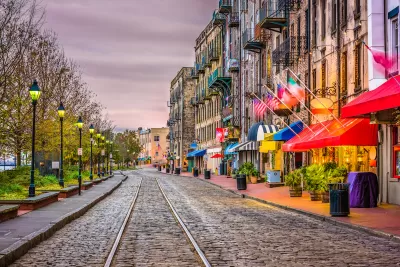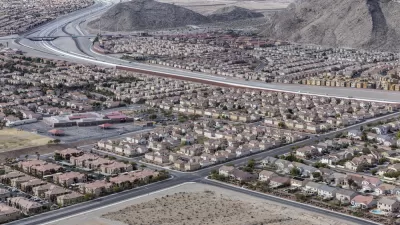From a human-scales, plaza-anchored grid to suburban sprawl, the oldest planned city in the United States has seen wildly different development patterns.

In a piece for Strong Towns, Edward Erfurt describes some lessons for urbanists drawn from the oldest planned city in the United States, Savannah, Georgia.
As Erfurt explains, “Savannah’s streets and blocks are organized around a series of squares” that divide parcels for private development. In the mid-20th century, urban renewal led to the destruction of older communities in favor of larger developments, eliminating some of the city’s historic walkability and human-scaled spaces.
As a result of these rapid and destructive changes, Erfurt argues, “Savannah is a city stuck in regulatory amber. All of the dramatic and radical change the city has experienced has hardened the position of residents to reject change.”
For Erfurt, Savannah is a great example of a city with “the full extremes” on the development spectrum, with historic areas revealing small-scale development patterns and sprawling suburbs. But modern mistakes shouldn’t freeze development in place, Erfurt writes. “Cities that are not exempt from change allow for the natural pattern of development to begin while restricting radical change. Allowing for small incremental changes, at scale, dispersed throughout the city, will thicken the historic grid of the city and continue Savannah’s success into the next 300 years.”
FULL STORY: Lessons on Development Patterns From America’s Oldest Planned City

Planetizen Federal Action Tracker
A weekly monitor of how Trump’s orders and actions are impacting planners and planning in America.

Restaurant Patios Were a Pandemic Win — Why Were They so Hard to Keep?
Social distancing requirements and changes in travel patterns prompted cities to pilot new uses for street and sidewalk space. Then it got complicated.

Map: Where Senate Republicans Want to Sell Your Public Lands
For public land advocates, the Senate Republicans’ proposal to sell millions of acres of public land in the West is “the biggest fight of their careers.”

Maui's Vacation Rental Debate Turns Ugly
Verbal attacks, misinformation campaigns and fistfights plague a high-stakes debate to convert thousands of vacation rentals into long-term housing.

San Francisco Suspends Traffic Calming Amidst Record Deaths
Citing “a challenging fiscal landscape,” the city will cease the program on the heels of 42 traffic deaths, including 24 pedestrians.

California Homeless Arrests, Citations Spike After Ruling
An investigation reveals that anti-homeless actions increased up to 500% after Grants Pass v. Johnson — even in cities claiming no policy change.
Urban Design for Planners 1: Software Tools
This six-course series explores essential urban design concepts using open source software and equips planners with the tools they need to participate fully in the urban design process.
Planning for Universal Design
Learn the tools for implementing Universal Design in planning regulations.
Heyer Gruel & Associates PA
JM Goldson LLC
Custer County Colorado
City of Camden Redevelopment Agency
City of Astoria
Transportation Research & Education Center (TREC) at Portland State University
Camden Redevelopment Agency
City of Claremont
Municipality of Princeton (NJ)





























